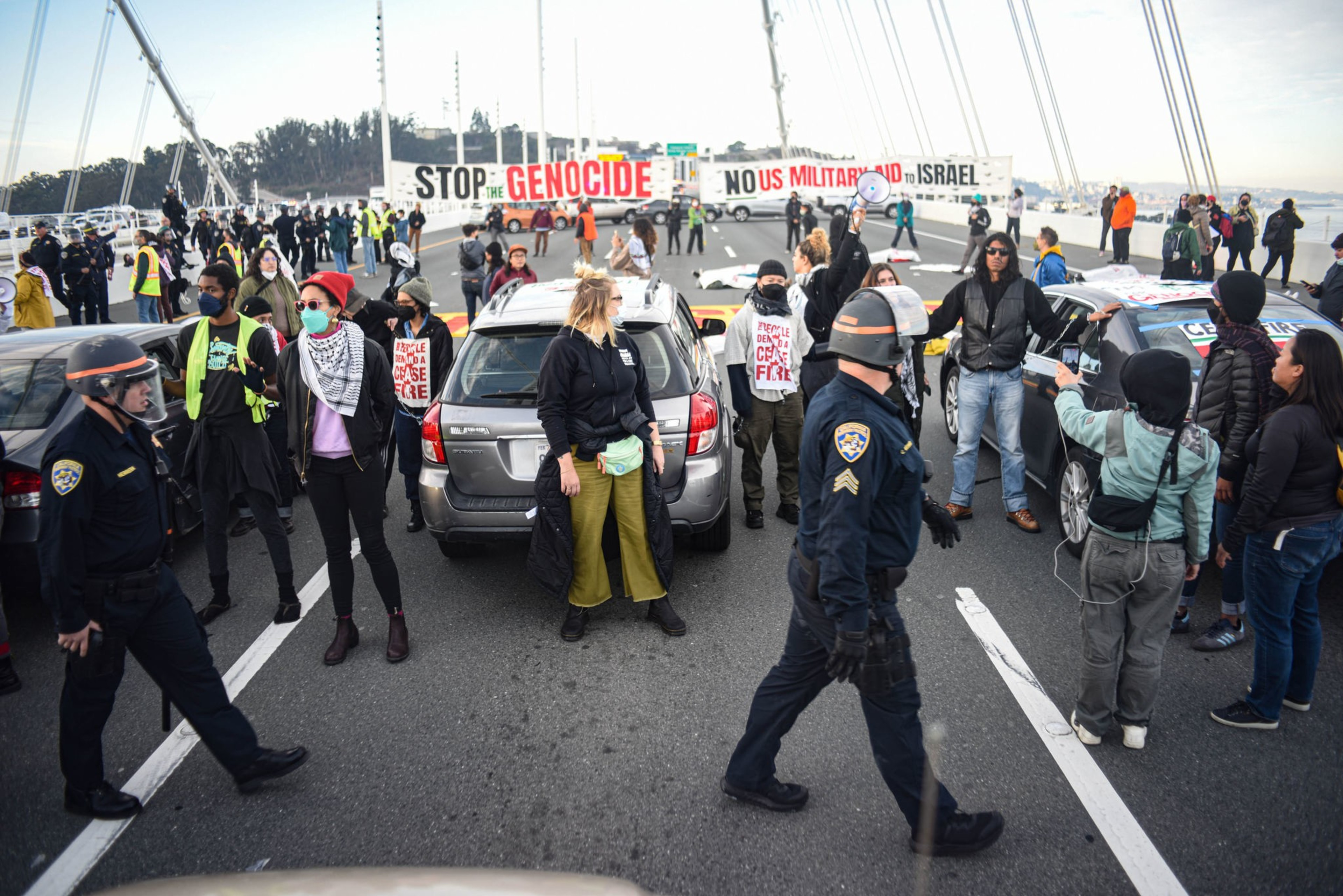Dozens of protesters pulled off a four–plus-hour blockade of westbound Bay Bridge lanes during the APEC summit, San Francisco’s highest-profile political gathering in years. How did they do it?
The Nov. 16 demonstrators demanded that President Joe Biden, who was in San Francisco for the Asia-Pacific Economic Cooperation gathering with other world leaders, call for an immediate cease-fire in Gaza.
It marked the longest shutdown of the Bay Bridge since 2016, when activists led by a group called Black.Seed blocked westbound lanes for 96 minutes on the afternoon of Martin Luther King Jr. Day. California Highway Patrol officers arrested about two dozen protesters (opens in new tab) within half an hour and reopened lanes within an hour (opens in new tab), but traffic backups lingered into the early evening.

November’s protest lasted more than twice as long and involved more than three times as many activists, severely inconveniencing thousands of people crossing into San Francisco.
It also came as a bit of a surprise, given that the California Highway Patrol had commandeered one lane of the bridge in each direction since the day prior, citing security concerns related to APEC.
“This was hours long,” John Goodwin, of the Metropolitan Transportation Commission, told The Standard. “I don’t recall an incident of this duration.”
CHP arrested 67 women and 13 men related to the demonstration. One protester was taken to jail, while the other 79 were cited and released. A total of 29 vehicles were towed, the California Department of Transportation confirmed.
To date, the San Francisco District Attorney’s Office has not filed charges against any of the protesters. The DA’s Office has not responded to a request from The Standard about the status of the cases.
How Protesters Blocked the Bay Bridge
The morning of Nov. 16 began as usual, according to official bridge toll counts: 22,522 vehicles drove from San Francisco to Oakland between 5 a.m. and 9 a.m., but just 11 made it across in the hour after 10 a.m.
All five lanes of the bridge were quickly blocked by protesters’ vehicles at 7:42 a.m., when demonstrators parked side-by-side under the tower just before the Treasure Island exit.
Traffic came to a standstill.
A Bay Area commuter, who joined the protest as it happened but wanted to remain anonymous due to fear of legal action, said they realized the demonstration was happening as they drove up to Treasure Island and traffic came to a standstill.
“People began to get out of their cars,” the commuter said. “As time passed and everything on the bridge came to a halt, I also got out of my car as everything on the bridge came to a halt. They weren’t driving lanes anymore; they were walking lanes.”
Protesters unfurled huge banners on the road demanding a cease-fire, staging a “die-in.” Many waved placards and banners as over 100 CHP officers and San Francisco County sheriff’s deputies stormed the bridge. Vehicles driven by office workers, school buses, semis and even a truck hauling portable toilets were trapped on the span for hours.
As the commuter walked from his car to the front of the protest, they observed others joining the protest with banners and signs and others hanging out on the bridge, smoking cigarettes.
“Protesters were all chained up to each other in the front in a line,” they said. “They were all chanting, calling for a cease-fire. There was a large banner in the middle of the protest. Someone had a bullhorn, and there were speakers looking like they were having a press conference.”
According to the commuter, organizers were addressing drivers and those protesters who were moving toward the front of the demonstration.
“There were a lot of people walking from far away to the protest area,” they said, adding that those who were protesters were easily recognizable walking up the bridge with banners and signs. “When people had gotten arrested, some protesters were still coming up there even as it ended.”
Some of the activists who abandoned their vehicles tossed their car keys into the bay in an effort to delay their removal, according to CHP Golden Gate Division spokesperson Officer Andrew Barclay. Protesters in their cars further behind the blockade got out of their vehicles and began handing out fliers to motorists.
Each flier began, “Hi, we know this interruption to your commute is frustrating and we wouldn’t do it if it weren’t incredibly urgent!”
The commuter confessed they never actually saw anyone throw their keys into the San Francisco Bay.
“It might have been that one or two people might have done it out of desperation.”
After pointing to the dire conditions in Gaza and the president’s presence at APEC, the protest urged readers to tune into an FM radio station, or to follow live broadcasts from Instagram accounts for the Palestinian Youth Movement, the Anti Police-Terror Project, the Arab Resource and Organizing Center Bay Area, Bay Area Palestine Solidarity and the Palestinian Feminist Collective.
Some drivers turned around on the bridge and began driving back toward Oakland by 8:20 a.m.
Passengers stuck in the mounting chaos also left vehicles and walked east along the bridge just after 9 a.m.
A Standard staffer even spotted commuters using the portable toilets on the back of the flatbed truck at 10:52 a.m.
Protesters tried to make it more difficult to be arrested by chaining their arms onto what appeared to be a drainpipe. Barclay told The Standard the pipe has handles inside, which activists gripped onto.
“However, those were easily removed with no problem, and they were taken into custody,” Barclay said.
By 11:55 a.m., the bridge had fully reopened to traffic, making the duration of the disruption four hours and 15 minutes.
The 2016 protest employed similar tactics to November’s cease-fire action but also used of chains.
The group that says it organized the cease-fire protests declined to comment for this story. Several protesters who were detained on the bridge could not be reached for comment.
